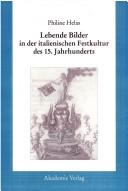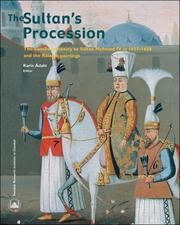| Listing 1 - 9 of 9 |
Sort by
|
Book
Year: 2005 Publisher: Sŏul T'ŭkpyŏlsi : Hyohyŏng Chʻulpʻan,
Abstract | Keywords | Export | Availability | Bookmark
 Loading...
Loading...Choose an application
- Reference Manager
- EndNote
- RefWorks (Direct export to RefWorks)
Processions in art. --- Drawing, Korean --- Pageants in art. --- History in art. --- Chŏngjo, --- Hwasŏng-gun (Korea) --- History
Book
ISBN: 3050076992 Year: 2014 Publisher: Berlin : Akademie Verlag,
Abstract | Keywords | Export | Availability | Bookmark
 Loading...
Loading...Choose an application
- Reference Manager
- EndNote
- RefWorks (Direct export to RefWorks)
,Lebende Bilder', auch unter der französischen Bezeichnung ,tableaux vivants' bekannt, sind ein verbreitetes Phänomen der italienischen Festkultur des 15. Jahrhunderts. Anders als die nach Kunstwerken gestellten ,lebenden Bilder' des 18./19. Jahrhunderts waren sie meist für den Anlass erfundene Darstellungen, die künstlerische Bildformulare und Gestaltungsprinzipien aufgegriffen und elaborierten. In Italien wurden sie auf einem Wagen oder Traggerüst in Prozessionen und Festzügen mitgeführt, gelegentlich belebten sie auch anstelle von Statuen Triumpharchitekturen oder waren als ,Paradiese' fest an einem hochgelegenen Ort eingerichtet. Die Inszenierung von ,lebenden Bildern' findet sich in unterschiedlichen Zusammenhängen und konnte sowohl religiöser und politischer Agitation wie der Repräsentation von Personen und kommunalen Vereinigungen dienen. In dem Buch werden die ,lebenden Bilder' auf ihre Erscheinungsformen, Funktionen, die zeitgenössische Rezeption und ihr Verhältnis zu den Bildenden Künsten untersucht. Da nur sehr wenige bildliche Dokumente überliefert sind, stützt sich die Analyse im wesentlichen auf die Auswertung bisher unbeachteter schriftlicher Quellen. Die Besonderheit des ,lebenden Bildes' in der visuellen Kultur des Quattrocento liegt darin, dass es, zwar von kurzer Dauer, jeweils an ein spezifisches, historisch bedeutungsvolles oder den jährlichen Zyklus prägendes Ereignis gebunden auftrat. Und sich so in das kollektive Gedächtnis einschrieb. Als ein Massenmedium trug es zur Tradierung, Popularisierung und Etablierung bestimmter Bildthemen oder Inhalte bei. Damit ist es, wie die Verbreitung von Buchdruck und Holzschnitt, ein Faktor des medialen Umbruchs im 15. Jahrhundert.
Tableaux (Art) --- Art, Italian --- Triumph in art. --- Processions in art. --- Themes, motives. --- Themes, motives.
Book
Year: 2005 Publisher: 서울 특별시: 효형 출판,
Abstract | Keywords | Export | Availability | Bookmark
 Loading...
Loading...Choose an application
- Reference Manager
- EndNote
- RefWorks (Direct export to RefWorks)
Processions in art --- Drawing, Korean --- Pageants in art --- History in art --- Chongjo, - King of Korea, - 1752-1800 --- Hwasong-gun (Korea)

ISBN: 3050034084 9783050034089 Year: 1999 Publisher: Berlin Akademie Verlag
Abstract | Keywords | Export | Availability | Bookmark
 Loading...
Loading...Choose an application
- Reference Manager
- EndNote
- RefWorks (Direct export to RefWorks)
Tableaux --- Art, Italian --- Triumph in art. --- Processions in art. --- Tableaux vivants --- Art italien --- Triomphe dans l'art --- Processions dans l'art --- Themes, motives --- Themes, motives. --- Thèmes, motifs --- Fêtes --- Processions --- Triomphe --- Rites et cérémonies --- Art --- Dans l'art. --- Thèmes, motifs. --- Thèmes, motifs. --- Parties --- Fêtes

ISBN: 9186884182 9789186884185 Year: 2006 Publisher: Istanbul : London : Swedish Research Institute in Istanbul ; I. B. Tauris, distributor,
Abstract | Keywords | Export | Availability | Bookmark
 Loading...
Loading...Choose an application
- Reference Manager
- EndNote
- RefWorks (Direct export to RefWorks)
Ambassadeurs suédois --- Ambassadors --- Art commissions --- Art ottoman. --- Art, Ottoman. --- Botschafter. --- Cour et courtisans --- Courts and courtiers --- Défilés --- Festumzug. --- Malerei. --- Processions in art. --- History --- History --- Dans l'art. --- Muhammad (Osmanisches Reich, Sultan, IV.). --- Rålamb, Claes, --- Rålamb, Claes, --- Rålamb, Claes. --- Geschichte 1657-1658. --- Empire ottoman --- Osmanisches Reich. --- Schweden. --- Turkey --- History
Book
ISBN: 1898823545 1898823499 9781898823544 Year: 2017 Publisher: Folkestone Renaissance Books
Abstract | Keywords | Export | Availability | Bookmark
 Loading...
Loading...Choose an application
- Reference Manager
- EndNote
- RefWorks (Direct export to RefWorks)
Fully illustrated in colour, here is the first introduction in English to one of Korea's outstanding cultural assets - the banchado ('painting of the order of guests at a royal event') - relating to all those taking part (1800 people) in the eight-day royal procession to Hwaseong (Gyeonggi Province) organized by King Jeongjo in 1795 for the dual purpose of visiting his father's tomb and celebrating his mother's sixtieth birthday. The banchado is a fine example of the meticulous record-keeping of the period (known as uigwe - the subject-matter of this book being known as the Wonhaeng eulmyo jeongni uigwe) and the skills of the court artists at that time. In addition to the banchado illustrations, the Wonhaeng eulmyo jeongni uigwe contains extensive lists of all the participants in the procession, details of the workers and technicians involved, including their duties and wages. It even includes the different foods offered at meal-times, the quantity of ingredients and the costs. The author provides a full analysis of the context, planning, execution and significance of the event.
Korea --- History --- Processions --- Pageants --- History in art. --- Processions in art. --- Drawing, Korean --- Pageants. --- Processions. --- Travel. --- Chŏngjo, --- Travel --- 1392-1910 --- Traveling --- Travelling --- Tourism --- Voyages and travels --- Pomp --- Rites and ceremonies --- Festivals --- Amateur plays --- Performing arts --- Historical art --- Art and history --- Korean drawing --- Chŏngjo Taewang, --- Jungjo, --- Yi Chŏngjo, --- Yi, Hong-jae, --- Yi Hongjae, --- Yi Sŏng, --- Yi, Sŏng, --- Yi, Hongjae, --- 正祖, --- 정조, --- art. --- court artists. --- cultural asset. --- gyeonggi province. --- hwaseong. --- royal travel. --- Hwasŏng-gun (Korea)
Book
ISBN: 9782503555164 9782503525556 9782503555171 2503525555 2503555160 Year: 2014 Volume: 15 Publisher: Turnhout Brepols
Abstract | Keywords | Export | Availability | Bookmark
 Loading...
Loading...Choose an application
- Reference Manager
- EndNote
- RefWorks (Direct export to RefWorks)
Denijs van Alsloot (vers 1568 ?- 1625/26) fut incontestablement le principal paysagiste à Bruxelles au début du XVIIe siècle. Il sut rapidement s'attirer les faveurs de la cour, où il occupa une position privilégiée. Ses paysages, composés à la fois d'éléments empruntés à l'héritage bruegélien et à une iconographie courtoise issue de l'art de la tapisserie, semblent avoir visé en premier lieu une clientèle de princes, de courtisans et de grands commis de l'état. L'ouvrage explore pour la première fois de manière systématique les différentes facettes de la production connue de van Alsloot. Composé de deux parties, il propose une étude qui non seulement repose sur une analyse des œuvres du point de vue stylistique et technologique, mais les situe aussi dans le contexte des pratiques d'atelier de l'époque et dans celui de la politique artistique des archiducs.
court art --- landscapes [representations] --- oeuvre --- Alsloot, van, Denis --- Ommegang in de kunst --- Optochten [Historische ] in de kunst --- Pageants in art --- Praalstoeten in de kunst --- Processies in de kunst --- Processions dans l'art --- Processions in art --- Spectacles historiques dans l'art --- Painters --- Landscape painting, Belgian --- Landscape painting, Flemish --- Peintres --- Peinture de paysages belge --- Peinture de paysages flamande --- Alsloot, Denijs van, --- Alsloot, Denijs van (1568?-162.). --- van Alsloot, Denijs --- Isabel Clara Eugenia --- Art patronage --- Albert --- Sallaert, Anthonis --- Landscape painting [Flemish ] --- 17th century --- Genre painting [Flemish ] --- Pageants --- Belgium --- Brussels (Belgium) --- History --- Processions --- Peinture baroque
Book
ISBN: 9782503543413 2503543413 Year: 2014 Publisher: Turnhout Brepols
Abstract | Keywords | Export | Availability | Bookmark
 Loading...
Loading...Choose an application
- Reference Manager
- EndNote
- RefWorks (Direct export to RefWorks)
The ephemeral art of festival, popular in the 16th and 17th centuries, was created for public events, such as triumphal processions, weddings and court funerals. Large-scale monuments combining painting, sculpture and the performing arts were devised for the duration of the event, but as soon as this was over, these extravagant constructions were dismantled and their individual components ultimately destroyed. Before the monuments ceased to exist, the city council would ensure their conservation in words and images, thus materializing the ephemeral art of festival into the more lasting medium of word and image on paper. One of the most celebrated such festive events was that of the 1599 Antwerp Triumphal Entry of Archduke Albert of Austria and the Infanta Isabella Clara Eugenia of Spain, the new Spanish governors of the Netherlands. This study offers a new approach to an analysis of the art of such events, based on Bochius' book: 'The Triumphal Entry of the Archdukes Albert and Isabella'.
Ceremonial entries --- Entrées (Cérémonies) --- History --- Sources --- Histoire --- Entrées (Cérémonies) --- joyous entry / Albert and Isabella --- Albert & Isabella [Archdukes] --- Festivals in art. --- Processions in art. --- Prints, Flemish --- Bochius, Joannes, --- 394 "15" --- 791.6 --- 76 <493> "14/16" --- Geschiedenis van België: 17de eeuw; Spaanse tijd (1555/1585-1713) --- Ritueel. Openbaar leven. Maatschappelijk leven. Banketten. Volksfeesten. Carnaval. Spelen. Dansen. Optochten. Jaarmarkt. Kermissen. Ruiterfeesten.--?"15" --- Feestelijkheden. Publieke feesten --- Grafische kunsten. Grafiek. Prentkunst--België--15e-17e eeuw. Periode 1401-1700 --- 791.6 Feestelijkheden. Publieke feesten --- 394 "15" Ritueel. Openbaar leven. Maatschappelijk leven. Banketten. Volksfeesten. Carnaval. Spelen. Dansen. Optochten. Jaarmarkt. Kermissen. Ruiterfeesten.--?"15" --- 949.3.022 Geschiedenis van België: 17de eeuw; Spaanse tijd (1555/1585-1713) --- Festivals --- Processions --- Themes, motives. --- Albrecht, --- Isabel Clara Eugenia, --- Belgium --- 949.3.022 --- iconography --- Iconography
Book
ISBN: 9781909400788 9781909400757 9781909400764 9781909400771 Year: 2016 Publisher: Turnhout Brepols
Abstract | Keywords | Export | Availability | Bookmark
 Loading...
Loading...Choose an application
- Reference Manager
- EndNote
- RefWorks (Direct export to RefWorks)
Cassiano dal Pozzo's print collection was unique in its scope and organisation. Some 3,000 prints are known, in nine albums and many loose impressions mainly divided between the British Library and the Royal Library at Windsor Castle. Cassiano (1588-1657) and his younger brother Carlo Antonio dal Pozzo (1606-89) did not commission printmakers to engrave plates (as they did drawings), buying instead what was available from the flourishing printmaking industry of the time. The material they collected was essentially documentary, and they organised the collection by subject matter: costumes, religious processions and ceremonies, tombs and catafalques, the history of St Peter's, architecture, topography, maps and military engagements, portraits, social and humorous subjects, and so on. This first part of the catalogue presents ceremonies, costumes, portrait and genre prints. A remarkable proportion of the prints are not to be found in the existing literature, and many constitute additions to the known works of major printmakers. Indeed Cassiano's collection has been described as 'so far outside the common range of print collectors both in the seventeenth century and today that a very high proportion of its contents is excessively rare and will only with great difficulty be found elsewhere'. This ground-breaking catalogue will be an essential resource not only for students of prints, but for all those studying European visual culture in the seventeenth century.
7.074 "16" --- 7.026 --- 76 <017.2> --- 7.026 Kunstwerken: copiëren reproduceren facsimile's --- Kunstwerken: copiëren reproduceren facsimile's --- 76 <017.2> Grafische kunsten. Grafiek. Prentkunst--Private verzamelingen --- Grafische kunsten. Grafiek. Prentkunst--Private verzamelingen --- 7.074 "16" Kunstverzameling. Activiteiten van verzamelaars--17e eeuw. Periode 1600-1699 --- Kunstverzameling. Activiteiten van verzamelaars--17e eeuw. Periode 1600-1699 --- Dal Pozzo, Cassiano (1588-1657) --- Dal Pozzo, Cassiano, --- 7.026 Kunstwerken: copiëren; reproduceren; facsimile's --- Kunstwerken: copiëren; reproduceren; facsimile's --- Prints, European --- Portrait prints, European --- Genre prints --- Rites and ceremonies in art. --- Rites et cérémonies --- Processions in art. --- Processions --- Clothing and dress in art. --- Costume --- Estampe --- Dans l'art --- Dans l'art. --- Collections privées --- Dal Pozzo, Cassiano --- Art collections --- Collections d'art. --- Windsor Castle. --- British Library --- Art collections. --- Rites et cérémonies
| Listing 1 - 9 of 9 |
Sort by
|

 Search
Search Feedback
Feedback About UniCat
About UniCat  Help
Help News
News